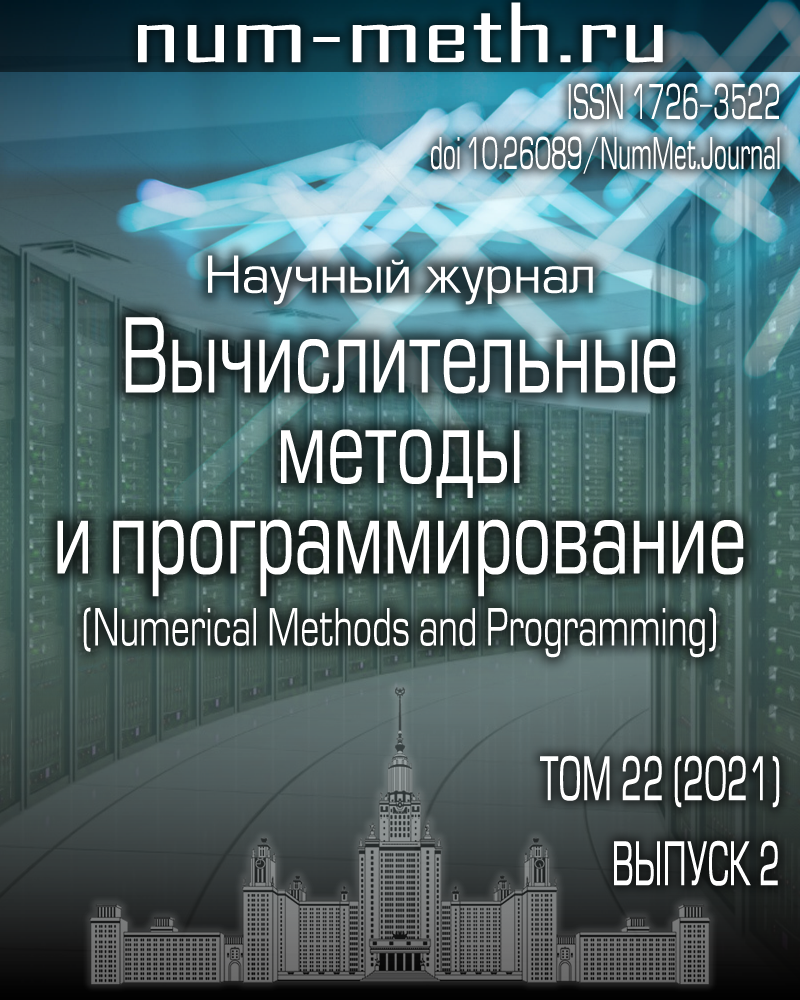DOI: https://doi.org/10.26089/NumMet.v22r207
Явные схемы высоких порядков точности для задач молекулярной динамики
Ключевые слова:
Аннотация
Рассмотрены явные симплектические разностные схемы Рунге–Кутты–Нистрема (RKN) с числом стадий от 1 до 5 для численного решения задач молекулярной динамики, описываемых системами с распадающимися гамильтонианами. Для числа стадий 2 и 3 параметры RKN-схем получены с помощью техники базисов Гребнера. Для числа стадий 4 и 5 новые схемы най дены с применением метода численной оптимизации Нелдера–Мида. В частности, для числа стадий 4 получены четыре новые схемы. Для числа стадий 5 получены три новые схемы в дополнение к четырем схемам, известным в литературе. Для каждого конкретного числа стадий найдена схема, являющаяся наилучшей с точки зрения минимума ведущего члена погрешности аппроксимации. Верификация схем осуществлена на задаче, имеющей точное решение. Показано, что симплектическая пятистадийная RKN-схема обеспечивает более точное сохранение баланса полной энергии системы частиц, чем схемы более низких порядков точности. Исследования устойчивости схем выполнены с помощью программного пакета Mathematica.
Опубликован
Выпуск
Раздел
Библиографические ссылки
- S. P. Kiselev, E. V. Vorozhtsov, and V. M. Fomin, Foundations of Fluid Mechanics with Applications: Problem Solving Using Mathematica (Birkhäuser, Boston, 1999).}
- S. K. Godunov, S. P. Kiselev, I. M. Kulikov, and V. I. Mali, Modeling of Shockwave Processes in Elastic-plastic Materials at Different (Atomic, Meso and Thermodynamic) Structural Levels (Inst. Komp’yut. Issled., Moscow-Izhevsk, 2014) [in Russian].
- L. D. Landau and E. M. Lifshitz, Course of Theoretical Physics , Vol. 1: Mechanics (Nauka, Moscow, 1973; Pergamon, Oxford, 1977).
- H. R. Lewis, D. C. Barnes, and K. J. Melendez, “The Liouville Theorem and Accurate Plasma Simulation,” J. Comput. Phys. 69 (2). 267-282 (1987).
- R. D. Ruth, “A Canonical Integration Technique,” IEEE Trans. Nucl. Sci. NS-30} (4), 2669-2671 (1983).
- M. Tuckerman and B. J. Berne, “Reversible Multiple Time Scale Molecular Dynamics,” J. Chem. Phys. 97 (3), 1990-2001 (1992).
- E. Forest and R. D. Ruth, “Fourth-Order Symplectic Integration,” Physica D 43 (1), 105-117 (1990).
- I. P. Omelyan, I. M. Mryglod, and R. Folk, “Optimized Verlet-like Algorithms for Molecular Dynamics Simulations,” Phys. Rev. E 65 (2002). doi 10.1103/PhysRevE.65.05670
- E. J. Nyström}, Über die numerische Integration von Differentialgleichungen (Acta Soc. Sci. Fenn., Helsingfors, 1925) [in German].
- L. Verlet, “Computer ’Experiments’ on Classical Fluids.I. Thermodynamical Properties of Lennard-Jones Molecules,” Phys. Rev. 159 (1), 98-103 (1967).
- Yu. B. Suris, “The Canonicity of Mappings Generated by Runge-Kutta Type Methods when Integrating the Systems ddot{x} =-partial U/partial x,” Zh. Vychisl. Mat. Mat. Fiz. 29 (2), 202-211 (1989)[USSR Comput. Math. Math. Phys. 29 (1), 138-144 (1989)].}
- V. N. Sofronov and V. E. Shemarulin, “Classification of Explicit Three-Stage Symplectic Difference Schemes for the Numerical Solution of Natural Hamiltonian Systems: A Comparative Study of the Accuracy of High-Order Schemes on Molecular Dynamics Problems,” Zh. Vychisl. Mat. Mat. Fiz. 56 (4), 551-571 (2016) [Comput. Math. Math. Phys. 56 (4), 541-560 (2016)].
- E. Hairer, S. P. Nørsett, and G. Wanner, Solving Ordinary Differential Equations I: Nonstiff Problems (Spinger, Berlin, 1993; Mir, Moscow, 1990).
- W. W. Adams and P. Loustaunau, An Introduction to Gröbner Bases. Graduate Studies in Mathematics. Vol. 3. (Amer. Math. Soc., Providence, 1996).
- J. A. Nelder and R. Mead, “A Simplex Method for Function Minimization,” Computer J. 7 (4), 308-313 (1965).
- D. I. Okunbor and R. D. Skeel, “Canonical Runge-Kutta-Nyström Methods of Orders Five and Six,” J. Comput. Appl. Math. 51 (3), 375-382 (1994).
- D. Okunbor and R. D. Skeel, “Explicit Canonical Methods for Hamiltonian Systems,” Math. Comput. 59 (200), 439-455 (1992).
- W. Schmidt and A. Jameson, “Euler Solvers as an Analysis Tool for Aircraft Aerodynamics,” in Advances in Computational Transonics (Pineridge Press, Swansea, 1985), pp. 371-404.
- V. G. Ganzha and E. V. Vorozhtsov, Computer-Aided Analysis of Difference Schemes for Partial Differential Equations (Wiley, New York, 2012).
Лицензия
Copyright (c) 2021 Е.В. Ворожцов, С.П. Киселев

Это произведение доступно по лицензии Creative Commons «Attribution» («Атрибуция») 4.0 Всемирная.


